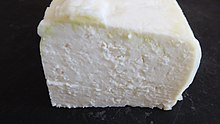Sour cheese
The sour cheese or Bloderkäse is a sour milk cheese from the St. Gallen region Werdenberg and Obertoggenburg , the Principality of Liechtenstein and the Vorarlberg Montafon . It has a fat content of only 4 to 15 percent and is available in three different degrees of maturity. The fresh cheese is very mild and grainy. After 60 days of storage, a very recent semi-hard cheese with a yellow rind has been created, which is also known as the “layer of bacon”.
designation
Werdenberger Sauerkäse , Liechtensteiner Sauerkäse and Bloderkäse have been protected designations of origin since 2010 . The production area includes the Werdenberg constituency , the Obertoggenburg communities Ebnat-Kappel , Wildhaus-Alt St. Johann and Nesslau , the adjacent community Amden and all communities in the Principality of Liechtenstein .

Traditionally, the different names are used depending on the production area. In Toggenburg, the term Bloderkäse or Ploderkäse is common, to the east of it the product is called sour cheese. The term Bloderkäse comes from "Bloder", which in the Toggenburg dialect describes the milk that has curdled itself. Alemannisch is the cheese in Toggenburg as Bloderchäs , in Werdenberg as Surchäs in Liechtenstein as Sura Käs and Montafon as Sura Kees referred.
For some time now, the various names have been assigned to the degrees of maturity. The unripened cream cheese is called bloder cheese by the manufacturers. Matured soft cheese with a layer of bacon, which is also intended for consumption, is called sour cheese.
In contrast to the sour cheese from the other production areas, the Montafon sour cheese is not block-shaped, but cylindrical.
→ Main article: Montafon sour cheese
Manufacturing
The traditional manufacturing process has hardly changed. The milk is skimmed, placed in a cheese kettle , warmed to 25 ° C and left to coagulate. Instead of the original spontaneous lactic acid fermentation, a mesophilic lactic acid bacterial culture is increasingly used, which is already active at a temperature of 25 degrees. Rennet is not added to the sour cheese because then the curdled milk would not turn sour. The warmed milk curdles exclusively through the lactic acid, the warming up and the leaving to stand.
In the next step, the curdled skimmed milk is heated to 35 to 38 degrees for a quarter of an hour while constantly stirring. A small amount of whole milk can be added to make it easier for the broken mass to be eliminated . The curdled milk is cut by hand or mechanically. The resulting cheese grains, which have separated from the whey , are filled into containers made of plastic, metal or wood - called bloder crates in Toggenburg. The whey that came with the skimming drains through the holes in the containers. After one day, the blocks of cheese, which weigh 100 grams to 8 kilograms, are lifted out of the mold and dry or salted in a salt bath for another two to three days. While the Montafon sour cheese has a cylindrical shape, rectangular blocks are common in the canton of St. Gallen and Liechtenstein.
In the cellar, the sour cheese is washed off regularly with water, and in the past also with must or coffee. Storage takes several weeks to a few months, depending on which layer of fat is preferred.
literature
- Surchäs / Bloder sour cheese (AOP). In: Culinary Heritage of Switzerland , accessed on November 15, 2018
- Summary of the registration application for Werdenberger sour cheese, Liechtenstein sour cheese and Bloder cheese.
- Reinhard Kobelt: Sur or Bloderchäs.
- Alpine farming currently.
- Everything about cheese.
- From everyday cheese to a delicacy.

